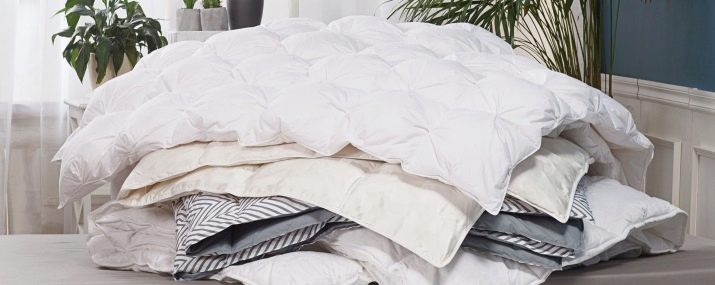All about holofiber blankets
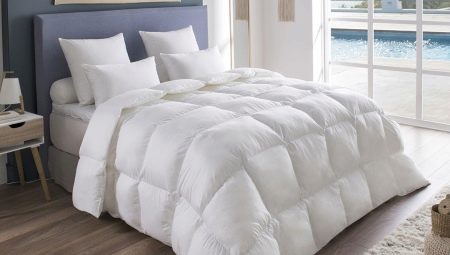
Questions about what holofiber blankets are, what are the pros and cons of this filler, whether it can be washed in a machine, are increasingly asked by those who purchase such bedding for the first time. Reviews of the new stuffing material are really impressive - they compare it with natural wool or down. A detailed story about why holofiber is better than synthetic winterizer, what advantages it has, will help you choose a blanket with such a filler without unnecessary difficulties.
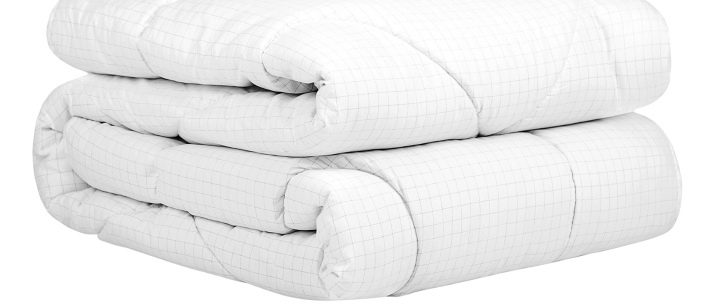
Advantages and disadvantages
The production of blankets with holofiber filling began relatively recently, but such products have gained popularity among buyers. Non-woven synthetic material was developed and patented in 2005 in Russia at the Termopol enterprise. The English version of the name, hollowfiber, is the best fit for its main characteristics, translated as "porous fiber". Consists of 100% polyester (polyester) material, can be produced in rolls, sheets or small balls.
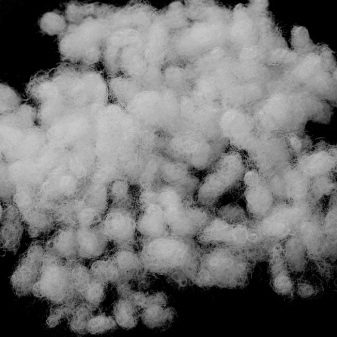

Among the obvious advantages of holofiber blankets, a number of characteristics can be distinguished.
-
Light weight. A blanket with such a filling is very light, "fluffy", since there are many air cavities between the fibers of the material.
-
Good thermoregulation. A holofiber blanket is always warm, it is impossible to freeze with it in winter, and in spring and autumn it will not be hot under such a cover.
-
Hypoallergenic filler composition. The fibers are connected in a glueless way, do not contain natural components that contribute to the reproduction of dust mites and pathogenic microflora. This is the safest option for young children, people with increased skin sensitivity.
-
Air permeability. The material "breathes", allowing the packing to quickly release the accumulated moisture. This property will be useful when washing bedding. At the same time, the blanket does not absorb foreign odors.
-
Resistant to deformation. Blankets with this type of filler do not "get lost", like their wadded or downy counterparts. Holofiber quickly restores its original shape when crumpled. Subject to the rules of care, the blanket will remain fluffy and airy for many years.
-
Minimal shrinkage. It is no more than 5% even with repeated washing.
-
Ease of care. The product can be dry cleaned, washed in drum machines with standard detergents.
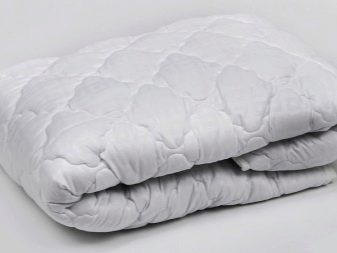
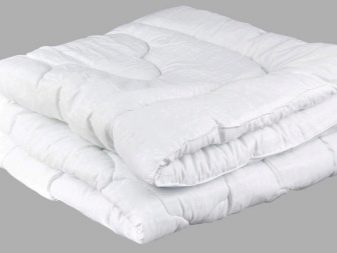

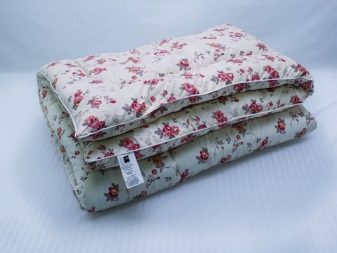
This filler also has disadvantages. These include low hygroscopicity, not exceeding 1%. And also the material requires a low temperature wash, it should not be exposed to too much heat.
Comparison with padding polyester
Most often, holofiber is compared with another filler for blankets - synthetic winterizer. It also consists of polyester fiber, but it is made with an adhesive, most often from recycled products.
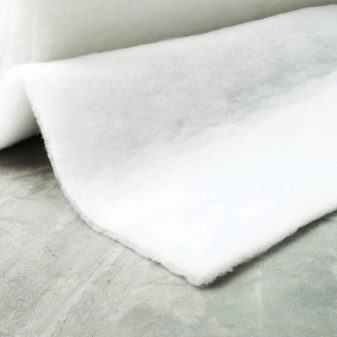
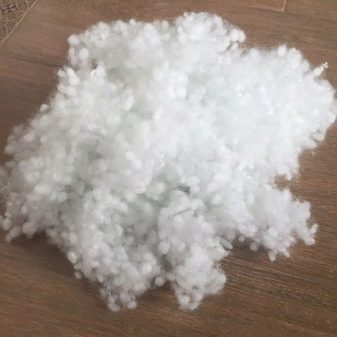
Comparing the characteristics of these materials will help to understand which type of stuffing is best for the blanket.
-
The ability to retain heat. Polyester fibers that are not glued together provide better protection from the cold. The synthetic winterizer warms up worse, it is looser, prone to the formation of lumps, which also impairs the characteristics of the filler.
-
Elasticity. According to this indicator, holofiber is noticeably superior to synthetic winterizer.
-
Resistant to wear and tear. Here, the leaders are also holofiber, which better withstands deformation loads. The synthetic winterizer breaks when stretched, does not restore its previous shape.
-
Hypoallergenic. The presence of glue particles in the synthetic winterizer leads to the appearance of a specific smell in it. Contact with these substances can cause allergic reactions. Holofiber is an environmentally friendly polyester that is safe for health.
-
Price. Here, the synthetic winterizer benefits from a cheaper production method, the possibility of using recycled raw materials.
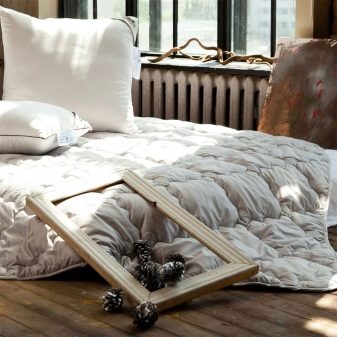
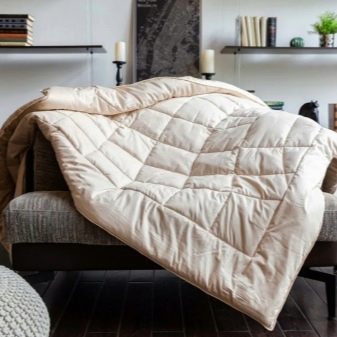
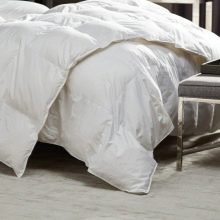
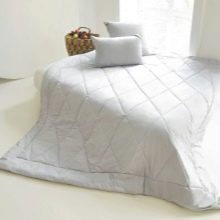

We can say that holofiber is an advanced polyester fiber material with lighter weight and improved performance. It loses to the synthetic winterizer only in one thing - in cost, but the other advantages clearly outweigh this small disadvantage.
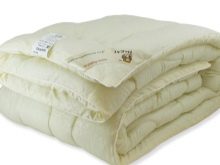
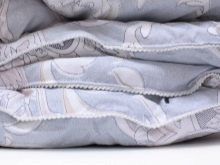

Views
The main classification of holofiber blankets involves their division according to the degree of density of the filler. This indicator should be indicated on the packaging in the form of dot symbols (there can be from 1 to 5, with an increase as the values increase) or figures in grams per square meter. The main classification looks like this:
-
summer - up to 180 g / m2;
-
light - up to 220 g / m2;
-
all-season - up to 350 g / m2;
-
warm - up to 500 g / m2;
-
super warm or winter - up to 900 g / m2.
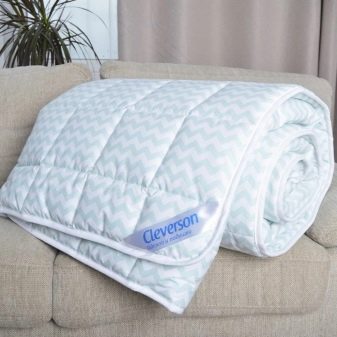
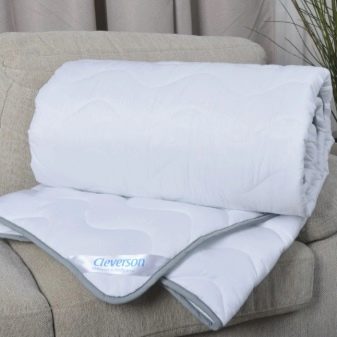
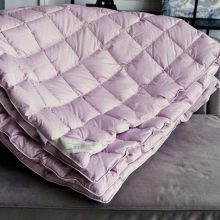

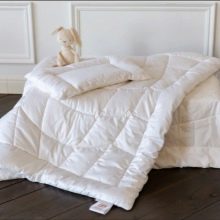
The packing density of the filler directly affects the weight of the product. The thinnest ones will be as light as possible. Blankets are also available in 2 layers. Usually lightweight and summer products are combined, which can be used together or separately, varying the degree of retained heat.
The second way to classify holofiber blankets is based on how the polyester fibers are distributed inside the cover.
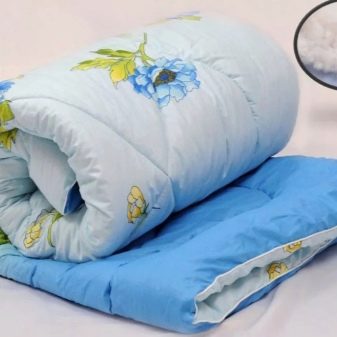
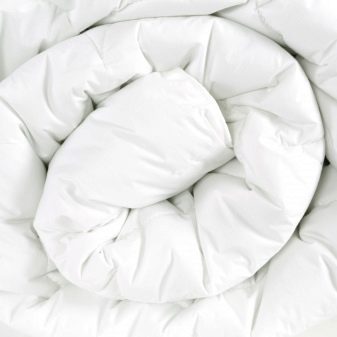
There are 3 main options, each with its own differences.
-
Quilted. In this design, the padding is stitched through the cover material. This is an inexpensive solution that allows you to significantly reduce the cost of the production process. In this case, as the operation progresses, the packing begins to "migrate", shift, and dips appear.
-
Karostep. This method of fixing the filler implies the creation of curly stitches, patterned or in the form of a clear pattern. It helps to fix the holofiber well inside the cover. This variant of the distribution of fibers does not imply their displacement.The more frequent and difficult the stitch is, the better the padding will hold.
-
Cassette. Blankets of this type are formed from separate insulated compartments with a filling inside. In this case, the packing does not move, and the product itself is as durable and strong as possible. Cassette blankets are the most expensive but are considered to be of the highest quality.
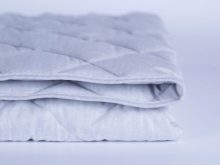
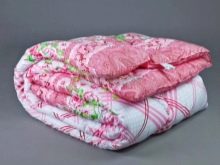
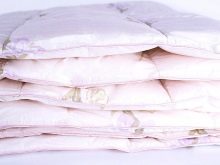
According to the type of cover fabric, all bedding can also be divided into synthetic and natural. Most often, cotton fabrics are used - coarse calico, satin, less often linen or synthetics.
Dimensions (edit)
Holofiber blankets produced by modern manufacturers are presented in a wide range of standard sizes. There are certain standards that define these parameters of bedding.
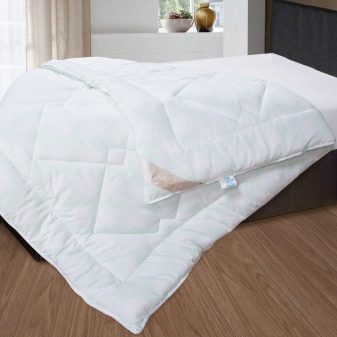

In the Russian classification, they are divided into the following categories:
-
for children - 110x140 cm;
-
single beds - 140x205 cm;
-
family or 1.5-bedroom - 155x215 cm;
-
2-bedroom - 170x205 cm;
-
euro - 220x240 cm.
These standards are typical for domestically produced products. When buying products from foreign companies, you may come across other size options. For example, the width of blankets can be 5 cm more or less, and the difference in length often reaches 20-25 cm. This can significantly affect the ease of use of bedding.

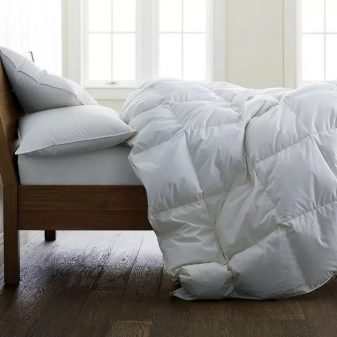
How to choose?
Choosing the right holofiber blanket is fairly easy when you consider all the important factors. First of all, you should give preference to factory production from a well-known brand. The filler material is patented in Russia, so domestic manufacturers deserve more confidence. It is better to buy a blanket personally in order to be able to evaluate its density and quality by touch, to see the type of stitching.
On personal inspection, it is also easier to pay attention to possible signs of a factory defect - curvature of stitches, traces of filler fibers, stray lumps of packing.
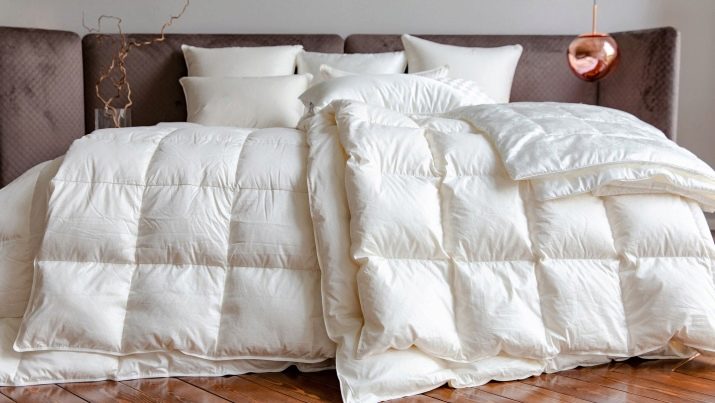
It will be useful to pay attention to the composition of the material from which the cover is made. It is better to give preference to dense satin or coarse calico; for summer products, a silk sheath is appropriate. When inspecting the product, it is quite possible to smell it. There should be no extraneous odors - they indicate that the inside is not hypoallergenic polyester, but a cheaper synthetic winterizer.
The dimensional characteristics and density of the filler are equally important. It is important to choose products for the season or from the very beginning to give preference to multilayer models that can be adapted to the desired temperature regime. When determining the size, it is worth focusing on the dimensions of the berth.
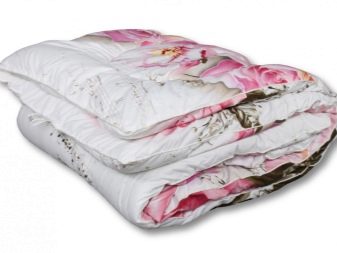
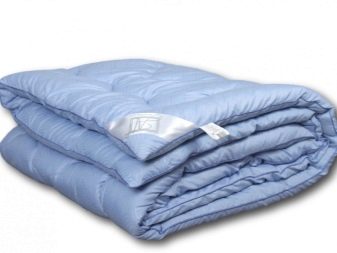
Care Tips
A blanket with holofiber as a filler does not require complex maintenance. It can be hand washed or steam cleaned for hygienic purposes. In this case, it is worth considering the type of cover material, which may require delicate handling. In the washing machine, products can also be processed at low temperatures no higher than 60 degrees. The filler is not afraid of intense wear, it tolerates drying and spinning well in the drum of the unit.
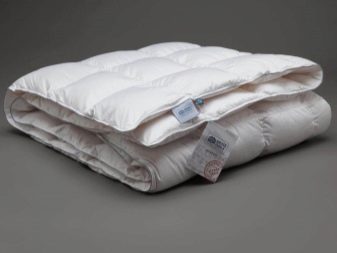
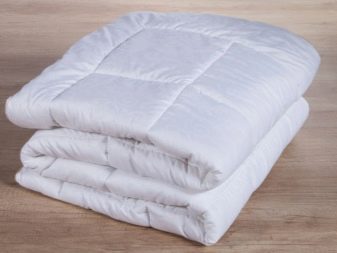
There are a number of useful recommendations for caring for a blanket filled with holofiber.
-
Refusal of a full wash with light dirt. Local cleaning or stain removal can be done. The more often the product is completely wet, the faster the fiber will lose its elasticity.
-
Pre-washing. It helps to treat heavily contaminated areas. First, they are soaked in soapy water, then rubbed with a brush or hands. After that, you can send the product to the wash.
-
Study of the manufacturer's recommendations. They can be important, because each product has a cover, which also has its own requirements for cleaning and washing. It is important to take into account all the subtleties in order to avoid possible mistakes. The main recommendations are always indicated on the label.
-
Using tennis balls. They come in handy when washing blankets with a filling that does not consist of a single piece of cloth. The balls loaded into the drum will prevent the material from rolling into lumps inside the cover.
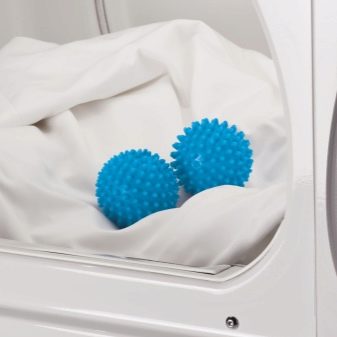
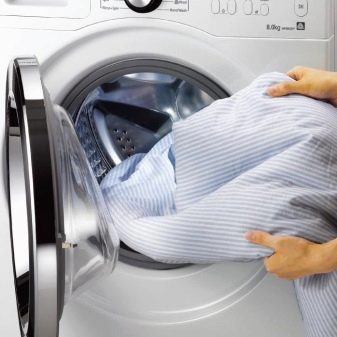
Considering all these recommendations, it is possible to keep the materials from which the blanket is sewn in good condition throughout their entire life cycle. Often it is not worth washing or cleaning products with aggressive chemicals. It is better to opt for delicate care to keep the blanket comfortable for sleeping.
Review overview
Blankets from holofiber, according to the people who purchase them, today constitute a serious competition for products with other types of fillers. They are highly valued for their lightness, comfortable feeling during sleep, as well as for the variety of options presented - from thick winter ones to thin summer ones.


Such blankets take up a minimum of shelf space during storage, easily fit into the drum of a conventional washing machine, and quickly recover their shape during drying.
Buyers note that there are options on sale for cots and adult bedrooms, you can choose the optimal size to your liking.
Any little thing can spoil the impression of buying a new blanket. If buyers do not have any complaints about the holofiber itself, then there are questions about the fabric from which the products are sewn. Cheap products with polyester inside are sewn from synthetic materials that generate static electricity and wear out quickly. Such a purchase may well be a cause for disappointment.
